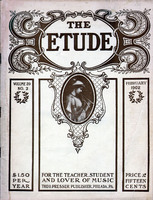It is not to be wondered at that “Special Musical Services,” particularly church-cantatas, are becoming very popular with our churches. To the regular church-goer the cantata enlarges and emphasizes the idea of the text which is taken from the Scriptures, and to those who rarely attend church the cantata appeals in a manner that is at once salutary. Many incidents of the Bible have been indelibly fastened in the minds of those who have heard a cantata, which, heretofore, were entirely forgotten soon after hearing them repeated in the pulpit. It is, therefore, not to be wondered at that our churches and ministers are led to adopt this method of teaching the Scriptures.
A score or more of years ago a form of the cantata was somewhat popular, but as most of the music, while simple in character and within the grasp of the choirs of the day, was more or less inane and devoid of interest to the average musician, the popularity of these cantatas was of short duration. Since that time the attention of choirs has been turned to the substantial cantatas of the English composers and other similar works, so that nowadays a large number of the prominent churches of the larger cities give one or more cantatas each season, and many of the churches give a series of a half-dozen or more prominent works during the season.
For short works, requiring only fifteen or twenty minutes for their performance, Gounod’s Gallia, for soprano solo and chorus, containing the well-known solo “Jerusalem, O Turn Thee”; Parker’s Redemption Hymn, for contralto solo and chorus; Mendelssohn’s Hear My Prayer, for soprano solo and chorus; Gade’s Christmas Eve, for contralto solo and chorus; and Gounod’s Out of Darkness, for quartet and chorus, are among the most popular. For longer works, requiring about forty-five minutes we suggest Stainer’s Daughter of Jairus, for soprano, tenor, and bass solos, with chorus; Stainer’s Crucifixion, with solo parts for tenor and bass; West’s Story of Bethlehem, for quartet and chorus; Saint-Saëns’ Christmas Oratorio, with solo parts for all four voices; Barnby’s Rebekah, with solos for soprano, tenor, and bass; Barnby’s The Lord is King, for quartet and chorus; and Dubois’ Seven Last Words of Christ, for soprano, tenor, bass, and chorus.
Still longer works and somewhat more difficult are Mendelssohn’s Hymn of Praise, Gaul’s Holy City and Ten Virgins, and Rossini’s Stabat Mater, all but the first requiring four soloists, are frequently given. It must not be understood that the above list of works contains all the desirable cantatas, as it is intended only as a partial list. There are many other works by American and foreign composers which are full of interest, and only the limits of this short article preclude their mention.



